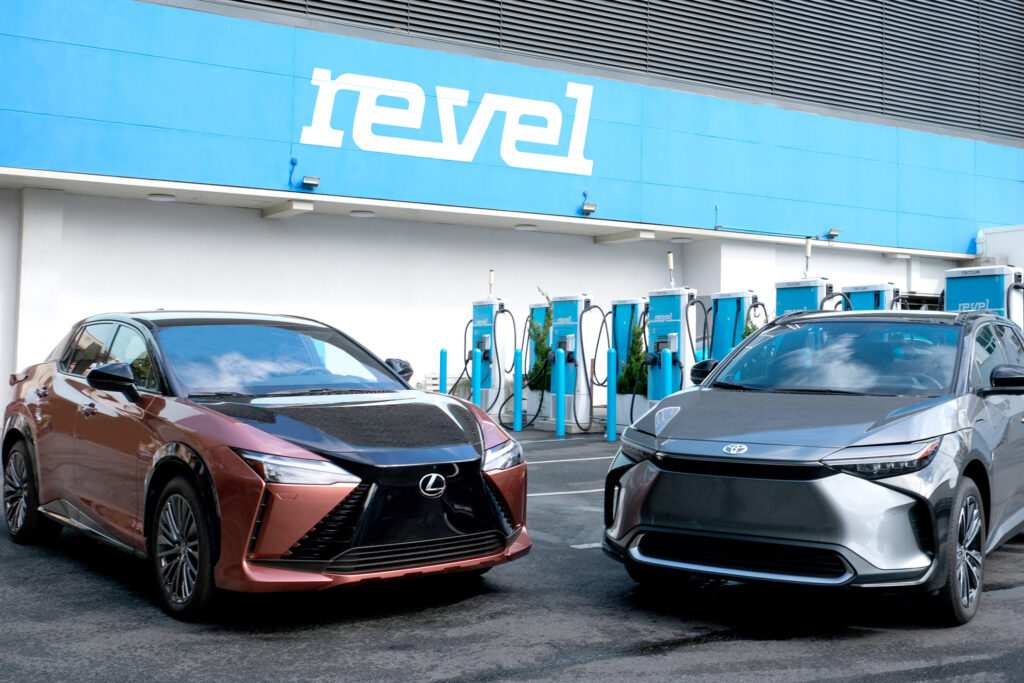EVs that charge using Level 2 plugs can get enough power for days worth of daily driver duties in 20 minutes to two hours. Fast charging can charge a vehicle to full more rapidly, depending on a model’s electric architecture and intra-vehicle algorithm-controlled charging limits.
Curbside charging has already been adopted in New York City and Los Angeles, some with cables, some without, though it is not abundant. Instead, cities are usually spending millions on more traditional style Level 2 charging infrastructure.
“Uncorded chargers are cheaper than corded chargers, allowing more chargers deployed for the same cost,” Hannon Rasool, director of the California Energy Commission’s Fuels and Transportation Division told Newsweek.
Today, many ultrafast charging stations are stationed alongside Level 2 chargers and don’t have amenities such as bathrooms and convenience store-like shopping akin to what is found at a gas station, but that’s changing too.
In the U.S., automakers like Mercedes and Volvo are starting to create their own charging stations at places with more potential “dwell time” like Starbucks. Dwell time is the measurement of how long people usually stay at a location. A longer dwell time means more opportunity to charge.
America’s IONNA charging network, which in many ways mirrors Europe’s IONITY charging network, is a collaborative attempt to create charging and dwelling hot spots. Automakers who are a part of the network include: BMW, General Motors, Honda, Hyundai, Kia, Mercedes-Benz, Stellantis and Toyota.
2024 Chevrolet Blazer EV charging. The 2024 Blazer EV can regain up to 78 miles of range in about 10 minutes on a DC fast charger.
2024 Chevrolet Blazer EV charging. The 2024 Blazer EV can regain up to 78 miles of range in about 10 minutes on a DC fast charger.
General Motors
Big cities face additional obstacles to widespread vehicle adoption beyond electric vehicle charging network installation for residents. They also have large numbers of commercial vehicles doing business at buildings across town. While many may leave the city proper to park at a depot and charge between business hours, others, like taxis, need to be able to charge on the go.
Ride hailing service drivers are electrifying their vehicle fleet five times faster than the general public, Uber shared. Those drivers may make dozens of trips during a shift, of a variety of lengths, and have extended downtime that could be used to charge.
Revel has the largest network of public fast charging in New York City. All of its chargers are either Level 2 or fast chargers. They are off-street and open 24/7 to any make or model vehicle. The company’s most recent expansion just opened at Pier 36 in Manhattan.
“There is certainly no one size fits all for charging, it will be a mix of fast charging stations like ours and overnight curbside charging. They serve different use cases. We’re very focused on electrifying the rideshare industry because those drivers are super users, they need a charge every time they do a shift and they want fast charging because every minute extra at the plug is time they could be on the road earning,” said Familiar.
As cities across the U.S. invest in more EV charging network infrastructure, they are studying each other’s moves.
Revel rideshare vehicle charging. The Revel company has several charging operations in New York City.
Revel rideshare vehicle charging. The Revel company has several charging operations in New York City.
Revel
“While certain standards can be broadly applied, each city must tailor its approach to address its unique needs. I think the biggest challenge in EV charging for the foreseeable future will be offering charging to folks who live and park in dense multifamily developments. With the cost of electric infrastructure and retrofit construction so high, this is a formidable challenge,” Ian Linssen, assistant to the city manager overseeing EV projects in Mesa, Arizona, told Newsweek.
Mesa mayor John Giles believes the onus is on the government to alleviate EV charging demand obstacles. “All levels of government need to step up to meet the growing demand,” he told Newsweek.
Source link : http://www.bing.com/news/apiclick.aspx?ref=FexRss&aid=&tid=6725ed95aedb453d90b5e39e95acec82&url=https%3A%2F%2Fwww.newsweek.com%2Famericas-ev-charging-network-starting-look-like-europes-1977319&c=11745615649818027694&mkt=de-de
Author :
Publish date : 2024-11-02 02:00:00
Copyright for syndicated content belongs to the linked Source.
